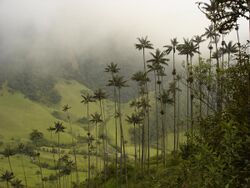Biology:Ceroxylon quindiuense
| Ceroxylon quindiuense | |
|---|---|

| |
| At Armenia, Colombia. | |
| Scientific classification | |
| Kingdom: | Plantae |
| Clade: | Tracheophytes |
| Clade: | Angiosperms |
| Clade: | Monocots |
| Clade: | Commelinids |
| Order: | Arecales |
| Family: | Arecaceae |
| Genus: | Ceroxylon |
| Species: | C. quindiuense
|
| Binomial name | |
| Ceroxylon quindiuense | |
| Synonyms[2] | |
| |
Ceroxylon quindiuense, often called Quindío wax palm,[3] is a palm native to the humid montane forests of the Andes in Colombia and Peru.[4]
Description
This palm species can grow to a height of 45 m (148 ft) —or rarely, even as high as 60 m (200 ft).[4] It is the tallest recorded monocot in the world.[5] The trunk is cylindrical, smooth, light colored, covered with wax; leaf scars forming dark rings around the trunk.[4] The leaves are dark green and grayish, 185–540 cm (6.1–17.7 ft) long, with a petiole up to 80 cm (31 in).[4] Fruits are globose and orange-red when ripe, 1.6–2 cm (0.6–0.8 in) in diameter.[4]
Taxonomy
Ceroxylon quindiuense was described by Gustav Karl Wilhelm Hermann Karsten and published in Bonplandia (Hannover) 8: 70. (1860).[2]
Ceroxylon: generic name composed of the Greek words: kèròs = "wax" and xγlon = "wood", in reference to the thick white wax found on the trunks.[6] quindiuense: geographical epithet alluding to its location in Quindío.
- Klopstockia quindiuensis H.Karst
- Ceroxylon floccosum Burret
Ecology
It grows in large and dense populations along the central and eastern Andes of Colombia (rarely in the western Colombian Andes), with a disjunct distribution in the Andes of northern Peru.[4] The elevational range of this species is between 2,000 and 3,100 m (6,600 and 10,200 ft) above sea level.[4] It achieves a minimum reproductive age at 80 years.[3] Wax palms provide habitats for many unique life forms, including endangered species such as the yellow-eared parrot (Ognorhynchus icterotis).
Vernacular names
Palma de cera, palma de ramo (both names in Colombia).[4]
Conservation
Populations of Ceroxylon quindiuense are threatened by habitat disturbance, overharvesting and diseases.[3] The fruit was used as feed for cattle and pigs. The leaves were extensively used in the Catholic celebrations of Palm Sunday;[7] such leaves coming from young individuals which were damaged to death.[3] That activity has been reduced severely in recent years due to law enforcement and widespread campaign.[4] Felling of Ceroxylon quindiuense palms to obtain wax from the trunk also is an activity still going on in Colombia and Peru.[4] The palm is recognized as the national tree of Colombia, and since the implementation of Law 61 of 1985, it is legally a protected species in that country.[3][8]
Cultivation and uses
The wax of the trunk was used to make candles, especially in the 19th century.[4] The outer part of the stem of the palm has been used locally for building houses, and was used to build water supply systems for impoverished farmers.[4][3] It is cultivated as an ornamental plant in Colombia and California.[4][3]
Gallery
References
- ↑ Bernal, R. (1998). "Ceroxylon quindiuense". IUCN Red List of Threatened Species 1998: e.T38467A10120959. doi:10.2305/IUCN.UK.1998.RLTS.T38467A10120959.en. https://www.iucnredlist.org/species/38467/10120959. Retrieved 11 November 2021.
- ↑ 2.0 2.1 2.2 2.3 "Ceroxylon quindiuense" (in en). Royal Botanic Gardens, Kew. http://www.plantsoftheworldonline.org/taxon/665697-1.
- ↑ 3.0 3.1 3.2 3.3 3.4 3.5 3.6 Madriñan, S.; Schultes, R.E. (1995). "Colombia's national tree: the wax palm Ceroxylon quindiuense and its relatives". Elaeis 7 (1): 35–56. http://botanica.uniandes.edu.co/investigacion/pdfs/Madrinan-Ceroxylon.pdf.
- ↑ 4.00 4.01 4.02 4.03 4.04 4.05 4.06 4.07 4.08 4.09 4.10 4.11 4.12 Sanin, Maria Jose; Galeano, Gloria (2011). "A revision of the Andean wax palms, Ceroxylon (Arecaceae)". Phytotaxa (34): 47–50. http://www.mapress.com/phytotaxa/content/2011/f/pt00034p064.pdf. Retrieved 26 January 2016.
- ↑ "Ceroxylon quindiuense - Palmpedia - Palm Grower's Guide". http://www.palmpedia.net/wiki/Ceroxylon_quindiuense.
- ↑ J. Dransfield & N. Uhl & C. Asmussen & W.J. Baker & M. Harley & C. Lewis (2008). Genera Palmarum. The evolution and classification of palms.
- ↑ "Bogotá, 'Reconcíliate con la Naturaleza' este Domingo de Ramos". http://www.bogota.gov.co/portel/libreria/php/frame_detalle_w3c.php?patron=01.&h_id=17916.
- ↑ Presidencia de la República de Colombia. "Símbolos patrios" (in es). http://wsp.presidencia.gov.co/asiescolombia/simbolos.html.
Wikidata ☰ Q907665 entry
 |









